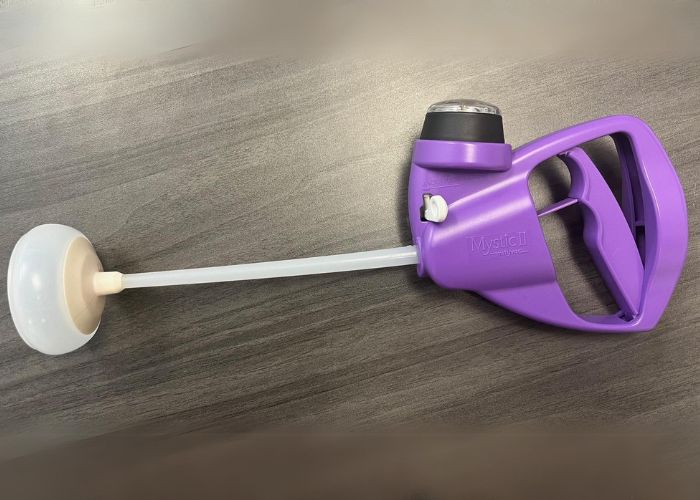The doctor heard a “pop” and was pleased.
A decade or so ago, CHOC pediatric neurosurgeon Dr. Michael Muhonen saw a patient with a “ping pong” skull fracture, so named because it left a depression on the infant’s head reminiscent of a dented ping pong ball.
He was looking for a suction device to correct the depression and avoid having to perform surgery. Since the early 1970s, some U.S. doctors had been using suction tools such as manual breast pumps and pediatric CPR masks to correct such injuries.
Dr. Muhonen was discussing the case with pediatric intensive care unit (PICU) nurse Esther Lin.
Esther had an idea: What about using a Mityvac Mystic II?
The Mystic II is an obstetric device commonly used for vacuum-assisted deliveries of newborns.
Esther was able to secure an obstetrical Mystic II from a neighboring adult hospital.
Dr. Muhonen tried it on the patient, heard the popping sound, and knew the device worked.
“The result was immediate and astounding,” recalls Esther, now a charge nurse in CHOC’s PICU.
The patient was promptly discharged.

About the injury
Fast forward to 2024.
Dr. Muhonen now has used the Mystic II device on several infants with ping pong skull fractures on an outpatient basis.
And earlier this year, he co-authored a research paper published in Child’s Nervous System that details the non-invasive efficacy of the device, which can be used on infants up to 6 months old.
Ping pong fractures are caused by birth-related trauma, short falls (typically from a bed) or when a parent inadvertently hits their infant’s head on a wall, door or other object while holding the baby as they walk around.
These fractures are caused by a lack of ossification in newborn skulls coupled with pressure that causes the top part of the skull to indent. Most ping pong fractures occur on the sides, top and front of the head.
Surgical correction is needed if there are complications such as increased intracranial pressure or signs of neurological impairment. But if there is no evidence of complicating factors such as these, elevation of the depression with the suction device can be a simple, quick and effective treatment for the fracture that can be done right at the child’s bedside.
How the device works
When using the Mystic II device, negative pressure is increased gradually and held for several seconds, and then the suction is released.
If necessary, the technique is repeated.
Typically, the Mystic II corrects the indented fracture within minutes.
Dr. Muhonen’s research paper, co-authored by Virginia Allhusen, manager of health sciences administration for the CHOC Neuroscience Institute, in addition to two former CHOC colleagues, concluded that the Mystic II is a “safe and effective noninvasive option” for infants that can be used under certain circumstances.
‘Excellent outcomes’
The study looked at seven CHOC patients with ping pong fractures from 2021 to 2022.
All seven underwent the procedure without anesthesia, and six of the seven experienced significant improvement in fracture site depression, with four displaying a complete fracture reduction and two displaying a significant reduction, the study concluded.
In two cases, two attempts of using the Mystic II lasting less than 5 seconds each corrected the fracture.
The device “avoids the need for open surgical intervention, anesthesia, or hospital admission, and can lead to excellent outcomes,” the study concluded.
Says Dr. Muhonen: “At CHOC, we are always looking for ways to improve the patient experience. Being able to offer a treatment like this that can be done at the child’s bedside with mom and dad right there as opposed to having to wheel the child into the operating room, administer anesthesia, send to recovery, and admit overnight. It’s a much better experience not just for the baby but for the worried parents as well.”

CHOC Hospital was named one of the nation’s best children’s hospitals by U.S. News & World Report in its 2025-26 Best Children’s Hospitals rankings and ranked in the neurology/neurosurgery specialty.




